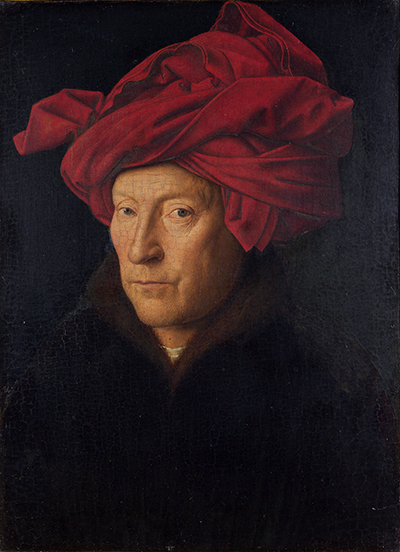This famous painting is considered by some to be a self portrait of Jan van Eyck, but this remains yet another unconfirmed topic of discussion from his prestigious career
The artwork has been dated confidently as 1433, whilst most of his work remains much more uncertain in terms of both its attribution and its timing. Artist Van Eyck was someone who produced commissions privately, in the main, with his Ghent Altarpiece being the main variation on that theme.
Whilst the subject of this portrait remains an item for discussion, there can be no doubt as to the quality of this piece. Some have claimed that perhaps he produced a self-portrait in order to promote his skills and earn more commissions but by the year 1433 his reputation would already have been strong enough to not require such a promotional activity.
The portrait itself has been given several different names of the years, including Portrait of a Man in a Red Turban, which provides a clearer definition of the painting. Despite this widely used title, it is actually a chaperon that is being worn in this artwork, with the artist choosing to tie it up whilst working. The artist put in an unusually large signature on this work, perhaps underlining his delight with the finished piece. His use of Als Ich Can (intended as "as I/Eyck can") was his standard signature, but it would normally be added much more subtlely. That is placed at the top of the artwork.
Jan van Eyck Made Me on October 21, 1433 is written on the top of the work, namely as Johes de Eyck Me Fecit Ano Mcccc.33. 21. Octobris. The frame and signature were considered by this artist to be a part of the painting itself, rather than just a presentational feature. That opinion was highly unusual during this period of art history.
The artist would compare himself with others, both current artists as well as those from the past. The precise wording of his signature is seen as a challenge to others to reach or exceed his artistic level.
This is an honest portrait where the slightest imperfection of the face is included by the artist, with middle-age being underlined by blood shot eyes and other features which have presumbly become more distinguished over time. The piercing gaze of the subject would suggest again that it is the artist himself in the picture, as a donor would be unlikely to accept a mood like this for themselves.
Evidence to suggest this to be a self-portrait is the subject's attire which is appropriate for the social standing that Van Eyck would have enjoyed at that time. A chaperon would appear again in the background of Rolin Madonna, suggesting that this might also be a self portrait. Artists have included themselves as background figures on several occasions, most famously being Diego Velazquez in Las Meninas.
The painting techniques and styles used in this portrait have been researched in great detail. The manner of the eyes, with a sharp focus at the viewer, reminds many of another self portrait by Albrecht Durer in 1500. The colours used in this piece include ultra marine for the irises, vermilion for the veins within the eyes plus reds and blues for the other elements of this part of his face.
Small dabs of white paint are carefully placed in order to give the impression of the reflection of light. The use of oils within art was relatively new at this time and was heavily promoted by Flemish artists, who took to it in droves. It was only later that Italian artists would replace egg tempera with this newer technique.




